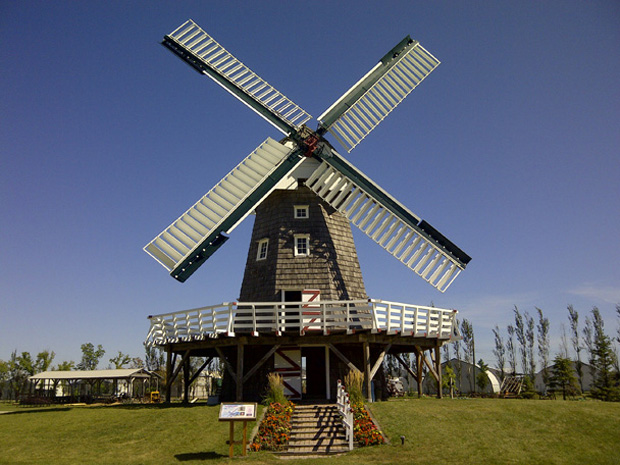In a traditional Mennonite village, the windmill would be located at the end of the village main street, and if possible on a hill or ridge. Because it was such a tall building, it could be seen by all the villagers as well as farmers in the surrounding countryside. So the miller would use the position of the sails to communicate messages to everyone.
If the sails were stopped in an X formation (ten o’clock, two o’clock), that would mean no milling, probably not enough wind or the miller would be off duty. If the sails had been moving and they were parked in a straight up and down position (twelve o’clock), that would mean the miller was having a short break and would resume shortly. If the sails were parked at a one o’clock position, they told of a happy event such as a birth or a wedding. Parked in the eleven o’clock position would indicate an occasion for mourning, perhaps a death had occurred or a serious accident or illness.
When we as millers at MHV tell the school kids about this “windmill language,” we usually get their attention, and they are fascinated because it is so far removed from the modern age of emails, cell phones, texting and Facebook.
The most important part of the windmill is the large sails. It is the movement of the sails that transforms the energy of the wind into the vertical rotation of the main shaft that drives the millstones below. Here are some interesting facts about our windmill:
- The sails always face into the wind. This is accomplished by the fantail, the small fan at the rear of the cap, which automatically turns the cap so the sails face the direction of the wind.
- The ideal amount of wind for milling is approximately 35-40 kilometers per hour. This only happens about once a week and is the major reason why Mr. Abraham Friesen’s windmill of 1877 (which ours is a replica of) did not survive very long. Just as our windmill stands idle on most days, so did Mr. Friesen’s.
- Mr. Friesen’s windmill stood at what is now the corner of Main Street and Friesen Avenue in downtown Steinbach.
- Our windmill has 5-foot-diameter grinding stones, and when the wind is ideal we are able to mill 300-400 lbs. of flour in an hour.
- Each stone weighs approximately 2000 lbs., and is made from granite.
- The milling stone makes 6.5 revolutions for each revolution the sails make.
- The sails turn counter-clockwise.
- The speed of the sails can be controlled by closing or opening the shutters on the sails with a chain on the deck of the windmill. A second chain on the deck operates the brake which is applied when the windmill is not being used.
- The framework of the windmill consists of eight Douglas-fir timbers, each being 32 feet in length. Each sail is approximately 30 feet in length, and the total structure towers more than 60 feet in the air.
- All the teeth on the wooden gears are lubricated with melted bees wax.
- We mill approximately 3000 lbs. of flour from May 1st to mid-October. About half of that is used to bake the bread served at our Livery Barn Restaurant, and the other half is sold in 3-lb. bags to people who visit MHV.
- Our flour is “natural” flour with no additives or preservatives.
The following is a description of what a traditional miller would do to mill flour. Today, we as millers at MHV carry out the procedure in much the same way.
- The first floor is where the farmers would bring their bags of cleaned wheat.
- The shaft that turns the top stone is connected to the larger gear wheel called the spurwheel.
- The single chain is pulled to release the brake on the sails, and the double chain is pulled to close the white shutters on the sails. This will get the sails turning and the windmill working.
- The bags of wheat are hoisted from the first floor through a trap door to the second (milling) floor with the elevator rope and emptied into the hopper.
- The wheat flows from the hopper by means of a small chute and feeds between the stones.
- The consistency of the flour is adjusted with a bar that sets the stones at a desired level.
- After the flour is ground, it flows down the chute into a bag on the first floor.
- To stop the mill, the top stone is raised, the white shutters on the sails are opened, the brake is applied and the gears disengaged.
Although the above are the basics, the actual milling requires attention, and adjustments may be needed during the process. I have had the privilege of operating this fascinating piece of machinery for the past eleven years, this year being my twelfth. On many occasions visitors have been present when the milling takes place, and they are always amazed to watch this happening. It has also given me the opportunity to meet many different people, from many different parts of the world, and to hear their stories and exchange different points of view. The windmill does indeed produce a feeling of village life, self-sustainability, simplicity, and agriculture – an expression of Mennonite values.




